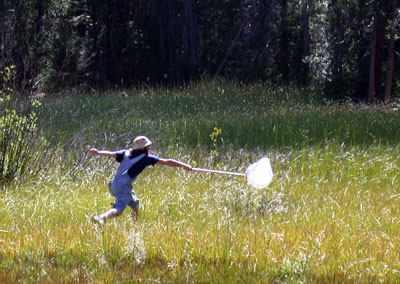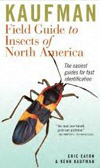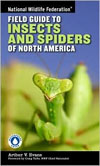
The summer insect season is upon us here in temperate North America, and with it comes the need for good identification guides.
Before I begin, a cautionary note. We have so many species on our continent that were we to create a bird-type guide that listed all the insects, with their ranges and identifying characteristics, the full set would span at least 30 volumes.  Any book small enough to carry into the field necessarily omits more than 95% of the relevant animals. Insect guides are understandably neurotic and overwhelmed compared to the corresponding bird and plant guides, and it's worth remembering that guides represent the author's judgment about which species are the most likely to be encountered. With no guarantee, of course, that the mysterious bug in your hand is common. Proper identification to species normally requires examination of a preserved specimen under high magnification with reference to the original taxonomic literature.
Having said all that though, let's throw caution to the wind. Here is my completely biased opinion* of the most prominent North American insect guides.
 Kaufman Field Guide to Insects of North America. The Kaufman guide was only published in the last couple years, but in that short period has become the first book I consult.  The reason is simple. This guide, written by Eric Eaton and Kenn Kaufman, makes no bones about being strictly an identification tool. The pages are packed with stylized photos, stripped from their habitats and laid out next to each other for easier identification. By skimping on the amount of text provided for each species, Eaton & Kaufman cover a broader array of species than competing guides- more than twice the number as the NWF guide, in fact. An insect is more likely to show up in the pages of this guide than any other. Of course, the lack of accompanying biological detail is frustrating, but that's the price of achieving both the smallest size and the greatest coverage. Highly recommended.
Kaufman Field Guide to Insects of North America. The Kaufman guide was only published in the last couple years, but in that short period has become the first book I consult.  The reason is simple. This guide, written by Eric Eaton and Kenn Kaufman, makes no bones about being strictly an identification tool. The pages are packed with stylized photos, stripped from their habitats and laid out next to each other for easier identification. By skimping on the amount of text provided for each species, Eaton & Kaufman cover a broader array of species than competing guides- more than twice the number as the NWF guide, in fact. An insect is more likely to show up in the pages of this guide than any other. Of course, the lack of accompanying biological detail is frustrating, but that's the price of achieving both the smallest size and the greatest coverage. Highly recommended.
 National Wildlife Federation Field Guide to Insects and Spiders of North America. This handsome volume, authored by Art Evans, stands out for the depth of information provided for the illustrated species. The photographs- many taken by the author- depict animals in their habitat, and the guide is among the most aesthetically pleasing books on the market. The inevitable trade-off of providing more text per species is that fewer species are covered. The NWF guide is not as likely to lead the reader to an identified insect as is the Kaufman guide, but the natural history detail in the text is much more satisfying for those insects that are included. Highly recommended.
National Wildlife Federation Field Guide to Insects and Spiders of North America. This handsome volume, authored by Art Evans, stands out for the depth of information provided for the illustrated species. The photographs- many taken by the author- depict animals in their habitat, and the guide is among the most aesthetically pleasing books on the market. The inevitable trade-off of providing more text per species is that fewer species are covered. The NWF guide is not as likely to lead the reader to an identified insect as is the Kaufman guide, but the natural history detail in the text is much more satisfying for those insects that are included. Highly recommended.
 National Audubon Society Field Guide to Insects and Spiders. Decades out of date, riddled with creative misidentifications, and arranged in an utterly nonsensical manner, this book will provide hours of surreal amusement. Some bugs are included with the beetles. There are moths in the wasps, and flies in the bees, except for the ones placed with the ticks. Or spiders. In the book's defense, the faux-leather binding is flexible and durable in the field, perhaps the most field-worthy of the lot, so you'll be able to abuse this book for years and still be able to misidentify your insects just as easily as when it was new. My advice? Don't bother. Not recommended.
National Audubon Society Field Guide to Insects and Spiders. Decades out of date, riddled with creative misidentifications, and arranged in an utterly nonsensical manner, this book will provide hours of surreal amusement. Some bugs are included with the beetles. There are moths in the wasps, and flies in the bees, except for the ones placed with the ticks. Or spiders. In the book's defense, the faux-leather binding is flexible and durable in the field, perhaps the most field-worthy of the lot, so you'll be able to abuse this book for years and still be able to misidentify your insects just as easily as when it was new. My advice? Don't bother. Not recommended.
 Peterson's A Field Guide to Insects. Peterson's is the grandaddy of insect guides, now several decades past the original printing and slipping out of date, and digestable only by the already entomologically literate. The vocabulary is technical, some of the characters arcane, and the illustrations are based on preserved specimens rather than live insects. Non-specialists may lack the technical chops to properly use this guide. Or is it another sign that today's kids just aren't as smart as they used to be? But I digress. For the persistent naturalist, the Peterson's Guide offers the best hope for identifying rare and unusual insects short of consulting the original taxonomic monographs. It's a rigorous, professional, and satisfying guide. If you've already passed Ent 101, that is. Recommended only for more advanced users.
Peterson's A Field Guide to Insects. Peterson's is the grandaddy of insect guides, now several decades past the original printing and slipping out of date, and digestable only by the already entomologically literate. The vocabulary is technical, some of the characters arcane, and the illustrations are based on preserved specimens rather than live insects. Non-specialists may lack the technical chops to properly use this guide. Or is it another sign that today's kids just aren't as smart as they used to be? But I digress. For the persistent naturalist, the Peterson's Guide offers the best hope for identifying rare and unusual insects short of consulting the original taxonomic monographs. It's a rigorous, professional, and satisfying guide. If you've already passed Ent 101, that is. Recommended only for more advanced users.
*disclaimer: The Kaufman and the NWF guide both licensed images from myrmecos.net in exchange for fistfuls of cash.
- Log in to post comments



A very helpful post and timely, as I'm an amateur in the market for a new guide. Glad to see your strong recommendation for the Kaufman; it's my favorite bird guide. Thanks!
Nice review, Alex - and I couldn't agree more with your recommendations. I think Audubon was trying to make theirs so it could be used in the same way their wildflower guides are used, with arrangments based on appearances only and having nothing to do with any taxonomic relationships. A backwards approach, in my opinion, since gaining awareness of the taxonomic distinctions allows users to eventually ID the many species they will encounter that are not in the guide at least down to family level. I never even look at it anymore.
But, you left out one of my favorites: Golden Nature Guide, Insects, by Herbert Zim & Clarence Cottam. Surely not competetive with the guides you review here, but as a child discovering the world of insects, that book was my bible. I had the 1956 edition, and it survives to this day in my library, its binding taped and retaped from the heavy use it received those many years ago. Those stylized paintings of dog day cicadas, harlequin bugs, and green June beetles are still burned in my memory.
p.s. the child with net photo is outstanding!
Thank you oh so much!!!
You may think it's funny but, as a European, I'm a proud owner of a Peterson's Field Guide to the Insects of North America (an edition from the 80's!) and I'm not only using it here in Belgium but I also recommend it to others. Yes I know that the systematics are on some places outdated and Europe isn't North America but .....
For a quick field guide I still find it one of the best and, if you know where the systematics have changed, one of the best to place insects you can find in the field. And, strange but true, even European insects. Yes, some groups are not known in North America but if you know that .....
And I like the methods in it, a line that points to the most important characteristics of the group they discuss, some small remarks about similar groups, little info about ecology, .....
It can compete with some of the best European guides and from some of them it wins with a big Hoeray!
Then, of course, there's the Borrow and Delong's Introduction to the insects; while some of the keys are downright horrible to work through (Coleoptera anyone?), it covers identification for every family of insect in North America.
"Insects; thier natural history and Diversity" by Stephen A.
Marshall
Not exactly a field guide but I pour over it like a kid looking through the window at an array of a candy. I've made my wish list from this book and you know what, sometimes I see one of the insects on the wish list just because I've ragged eared the pages of this book.
Kai & MJ:
Both fine suggestions, the Borror and the Marshall. An earlier version of this post included both of those (large & heavy) books, as well as some regional guides and online resources, but then I decided to strip it down to just the guides in "classic" small form.
Or is it another sign that todayâs kids just arenât as smart as they used to be? Or maybe it is a sign you are both stupid about different things?
But seriously, thank for this post. I run into a similar problem when recommending beachcombing guides.
Entomology was my favorite subject in college and I really appreciate your break down of these guides (I definitely have a few).
Thanks for mentioning NWF among the group- I'm definitely bookmarking your blog!
As far as regional guides go, for our region I like "Insects of the Great Lakes Region" by Gary Dunn, except for one thing: all it has are black-and-white line drawings, no pictures. On the other hand, I suppose this forces the user to focus more on details other than color, which can be useful. I also like that it gives a lot of references to the primary literature, so when the user wants to know more, it is easy enough to follow up. The Kaufman guide makes a really nice mate to it, because it has the pictures but not so much of the descriptions or references.
I really do like regional guides in general, because I rarely get out of the Great Lakes region, so I don't really need a field guide that is packed up with all the insects that live in, say, Florida but are never found in Michigan.
Heh, that's like me when I was a kid!
Bummer -- I own two of these, and not the two you recommend!
Alleviating the error asap!
Great recommendations. Your misgivings about the National Audubon Guide remind me of my own about the entire series. When the series was created, it looked like the overriding goal was to put out photographic portable field guides as soon as possible, based on the probably correct assumption that a large segment of the public preferred photographs to line drawings or paintings (even though most naturalists seem to agree that the latter are better for identification). National Audubon's involvement presumably was licensing the use of their name in what would be a project that would promote their general ends. (I presume this because the vast majority of birders preferred field guides with paintings, not photos.)
Thus, the series is inconsistent between volumes in their utility. The tree guide is fine, the wildflowers western region mediocre (and the first printing contained at least 2 misidentifications out of the 200 species that I was familiar with as a botanist; out of 600 in the book) and of limited value due to the small percentage they can include when they cover such a large area (no more than 10%); reptiles and amphibians OK; the birds guides mediocre, and pointless when there were already several excellent field guides on the market.
My general impression is that the more prominently an author's or editor's name features in the title, the better the field guide series. Kaufman's name features prominently on the cover, showing he is staking his reputation as a naturalist on its quality. Same with the Peterson Field Guide series, same with Stokes. With the Audubon series, you have to search inside to locate each author's name, in small print, on the title page.
Some years ago, a college student called my bookstore interested in purchasing a complete set of the Audubon guides, and when I tried to tell her that they weren't all that good, she seemed to think I was dissing the Audubon Society. Too bad that Audubon didn't initiate the guides themselves and take a "Let's make the best field guide series anyone has ever seen, based on the best qualities of decades of field guides already published" approach. If they had tapped into the expert field knowledge of their membership, they could have had an outstanding series.
A final note, Borror and White was my first insect field guide, and the one I learned the insect orders from, and I've had no college entomology courses. But then, at the time, I was a teenager wading into ponds and netting aquatic insects for my pond water aquarium, and making some use of library copies of Aquatic Invertebrates of the US (Pennak) and Aquatic Insects of California (Usinger), so I guess I'm not normal. But then, if one studies insects, how can you be?